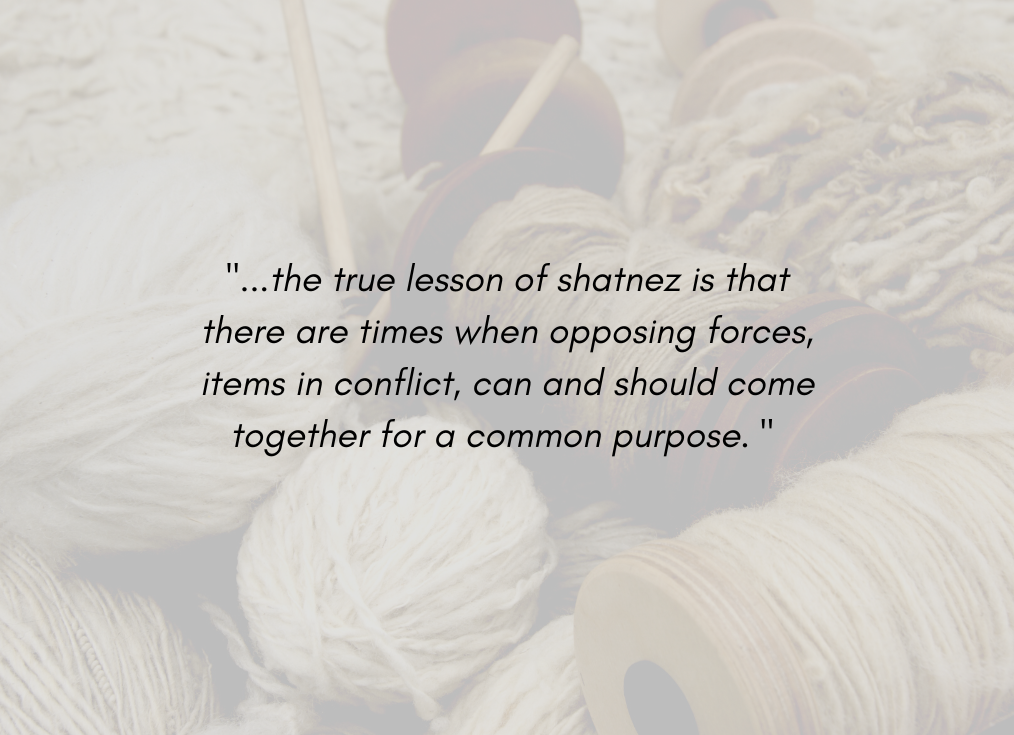Weaving the Fabrics of Our Community

March 3, 2023 / 10 Adar 5783
This week’s Torah portion, Tetzaveh, goes into great detail describing the priestly garments. We read about the layers of tunics and aprons, the beautiful breastplate displaying the tribal gemstones, and a final cloak with golden bells. Yet, oddly, in the long and descriptive text, there is a piece of clothing that breaks all the rules… the avnet, a belt made of blending materials forbidden to be used together.
In Jewish tradition, there is a law known as shatnez. This is an obscure law to most contemporary Jews; however, it is one that is adhered to closely by the Orthodox community. Shatnez is the prohibition against wearing a garment made of mixing wool and linen together. The law comes from Deuteronomy 22:11 and is supported in Leviticus 19:19.
Although there is no clear reason provided for this law, it is nonetheless a law stated explicitly in the Torah and therefore leaves no room for modern interpretation. Rabbis, over the years, have tried to provide context; however, it is simply known as a law without explanation.
This leads us to the obvious question, why would Gd require the High Priest to wear a vestment that would otherwise be forbidden to the common Jew? And what is the lesson that Gd teaches us through this requirement?
…
As you can imagine, there is great debate on this topic. In fact, one of the important insights learned from this contradiction is that when commandments come into conflict with one another, the “positive” commandment takes precedence over the “negative.” This is why one is allowed to take medicine on Yom Kippur or drive to the hospital on Shabbat, etc.
But the true lesson of shatnez is that there are times when opposing forces, items in conflict, can and should come together for a common purpose. Sometimes keeping things separate is healthy, is timely, and is safe. Yet, as we learn from the avnet in this week’s parshah, nothing should be kept apart forever. In fact, ironically, of all the vestments the priests were required to wear, the belt symbolized the article of clothing that kept everything in its place. Additionally, like a scale, it was the “accessory” that brought balance to the body, located in the midriff near where the hands would fall and wrapped in a way that would constantly be touched, reminding the priest of their role to represent the entire community and never lean toward one side over the other.
Throughout history, humanity has gone through the ebb and flow of polarizing times. We have seen the ramifications of digging in our heels and declaring war upon our enemies. We are all familiar with Santayana’s famous quote, “Those who cannot remember the past are condemned to repeat it.”
Today may or may not be worse than during times past. I cannot say. However, what I do know is that each of us has the ability to lower the temperature to allow for cooler heads to prevail. We throw around the phrase “climate change” whenever the weather acts erratically. But what of our own personal climate? How are we managing those winds of change?
In my role at the Jewish Federation, I frequently visit community events and speak to Jewish San Antonians with widely varying perspectives on Jewish tradition, the state of education, our legal system, and much more. And although the opinions and viewpoints are often diametrically opposed to one another, I ask myself how did Hillel and Shammai, two of the most famous opposing schools of historic Jewish thought, keep the Jewish community united with a common vision?
It is because we are more alike than we are different. Our common history, our shared traditions, and our mutual patriarchs and matriarchs remind us that we are all one family. Yes, no family is perfect, and not every family has peace in the home 100% of the time. But like in any family, when times get tough, we set aside our differences and work together for a common goal.
This week’s Torah portion is a reminder that as different as our thinking might be today, we have those who are linen and those who would be the wool; it is time that we come together like the avnet for the holy purpose of building a united Jewish community not only here in San Antonio, and not only across the United States, but also, in Israel and across the diaspora. Because we are…
Shabbat Shalom,

